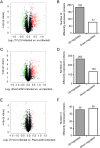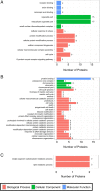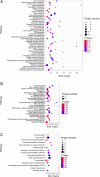Comparative proteomic analysis provides new insight into differential transmission of two begomoviruses by a whitefly
- PMID: 30857562
- PMCID: PMC6413443
- DOI: 10.1186/s12985-019-1138-4
Comparative proteomic analysis provides new insight into differential transmission of two begomoviruses by a whitefly
Abstract
Background: Viruses in the genus Begomovirus (Family Geminiviridae) include many important economic plant viruses transmitted by whiteflies of the Bemisia tabaci species complex. In general, different begomoviruses may be acquired and transmitted by the same whitefly species with different efficiencies. For example, the species Mediterranean (MED) in this whitefly species complex transmits tomato yellow leaf curl virus (TYLCV) at a higher efficiency than papaya leaf curl China virus (PaLCuCNV). However, the proteomic responses of whitefly to the infection of different begomoviruses remain largely unknown.
Methods: We used iTRAQ-based proteomics coupled with RT-qPCR to investigate and compare responses of the MED whitefly to the infection of TYLCV and PaLCuCNV.
Results: Totally, 259, 395 and 74 differently expressed proteins (DEPs) were identified in the comparisons of TYLCV-infected vs. un-infected, PaLCuCNV-infected vs. un-infected, and TYLCV-infected vs. PaLCuCNV-infected whiteflies, respectively. These proteins appear associated with catabolic process, metabolic process, transport, defense response, cell cycle, and receptor. The comparisons of TYLCV-infected vs. un-infected and PaLCuCNV-infected vs. un-infected shared some similar DEPs, indicating possible involvement of laminin subunit alpha, dystroglycan, integrin alpha-PS2 and cuticle proteins in viral transport as well as the role of putative defense proteins 3 and PITH in anti-viral response. However, 20S proteasome subunits associated with regulation of virus degradation and accumulation were up-regulated in PaLCuCNV-infected but not in TYLCV-infected whiteflies, which may be related to the constraints of PaLCuCNV accumulation in MED.
Conclusions: These findings provide valuable clues for unravelling the roles of some whitefly proteins in begomovirus transmission.
Keywords: Begomovirus; Virus transmission; Whitefly; iTRAQ-based proteomics.
Conflict of interest statement
Ethics approval and consent to participate
Not applicable.
Consent for publication
Not applicable.
Competing interests
The authors declare that they have no competing interests.
Publisher’s Note
Springer Nature remains neutral with regard to jurisdictional claims in published maps and institutional affiliations.
Figures






Similar articles
-
Specific cells in the primary salivary glands of the whitefly Bemisia tabaci control retention and transmission of begomoviruses.J Virol. 2014 Nov;88(22):13460-8. doi: 10.1128/JVI.02179-14. Epub 2014 Sep 10. J Virol. 2014. PMID: 25210181 Free PMC article.
-
Vector development and vitellogenin determine the transovarial transmission of begomoviruses.Proc Natl Acad Sci U S A. 2017 Jun 27;114(26):6746-6751. doi: 10.1073/pnas.1701720114. Epub 2017 Jun 12. Proc Natl Acad Sci U S A. 2017. PMID: 28607073 Free PMC article.
-
The level of midgut penetration of two begomoviruses affects their acquisition and transmission by two species of Bemisia tabaci.Virology. 2018 Feb;515:66-73. doi: 10.1016/j.virol.2017.12.004. Epub 2017 Dec 19. Virology. 2018. PMID: 29272747
-
Factors Determining Transmission of Persistent Viruses by Bemisia tabaci and Emergence of New Virus-Vector Relationships.Viruses. 2021 Sep 11;13(9):1808. doi: 10.3390/v13091808. Viruses. 2021. PMID: 34578388 Free PMC article. Review.
-
Transmission of Begomoviruses and Other Whitefly-Borne Viruses: Dependence on the Vector Species.Phytopathology. 2020 Jan;110(1):10-17. doi: 10.1094/PHYTO-07-19-0273-FI. Epub 2019 Nov 18. Phytopathology. 2020. PMID: 31544592 Review.
Cited by
-
A vector whitefly endocytic receptor facilitates the entry of begomoviruses into its midgut cells via binding to virion capsid proteins.PLoS Pathog. 2020 Dec 3;16(12):e1009053. doi: 10.1371/journal.ppat.1009053. eCollection 2020 Dec. PLoS Pathog. 2020. PMID: 33270808 Free PMC article.
-
Molecular insight into cotton leaf curl geminivirus disease resistance in cultivated cotton (Gossypium hirsutum).Plant Biotechnol J. 2020 Mar;18(3):691-706. doi: 10.1111/pbi.13236. Epub 2019 Sep 30. Plant Biotechnol J. 2020. PMID: 31448544 Free PMC article.
-
Transovarial transmission of tomato yellow leaf curl virus by seven species of the Bemisia tabaci complex indigenous to China: Not all whiteflies are the same.Virology. 2019 May;531:240-247. doi: 10.1016/j.virol.2019.03.009. Epub 2019 Mar 18. Virology. 2019. PMID: 30933715 Free PMC article.
-
Plant Antiviral Immunity Against Geminiviruses and Viral Counter-Defense for Survival.Front Microbiol. 2019 Jun 26;10:1460. doi: 10.3389/fmicb.2019.01460. eCollection 2019. Front Microbiol. 2019. PMID: 31297106 Free PMC article. Review.
-
Plant-virus-insect tritrophic interactions: insights into the functions of geminivirus virion-sense strand genes.Proc Biol Sci. 2020 Oct 14;287(1936):20201846. doi: 10.1098/rspb.2020.1846. Epub 2020 Oct 14. Proc Biol Sci. 2020. PMID: 33049166 Free PMC article.
References
-
- Rosen R, Kanakala S, Kliot A, Pakkianathan BC, Farich BC, Santana-Magal N, Elimelech M, Kontsedalov S, Lebedev G, Cilia M, Ghanim M. Persistent, circulative transmission of begomoviruses by whitefly vector. Curr Opin Virol. 2015;15(1–8). - PubMed
Publication types
MeSH terms
Supplementary concepts
LinkOut - more resources
Full Text Sources
Medical

